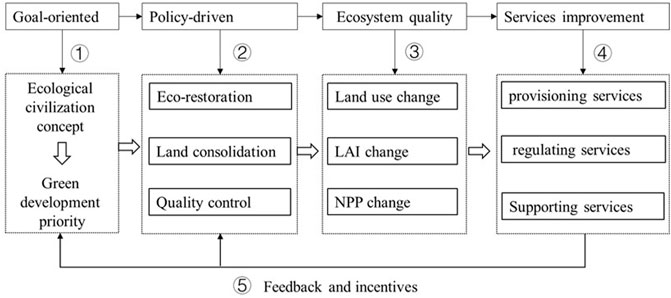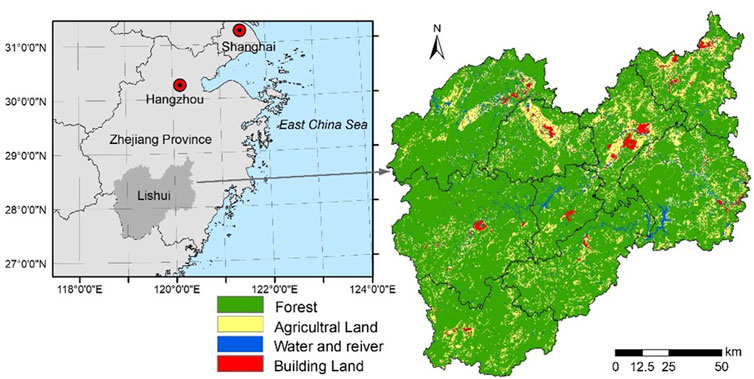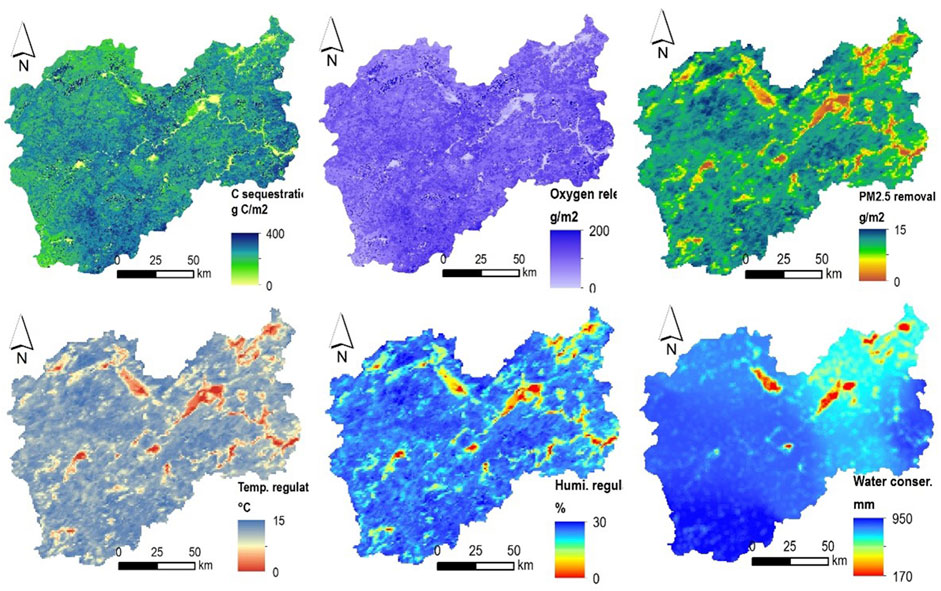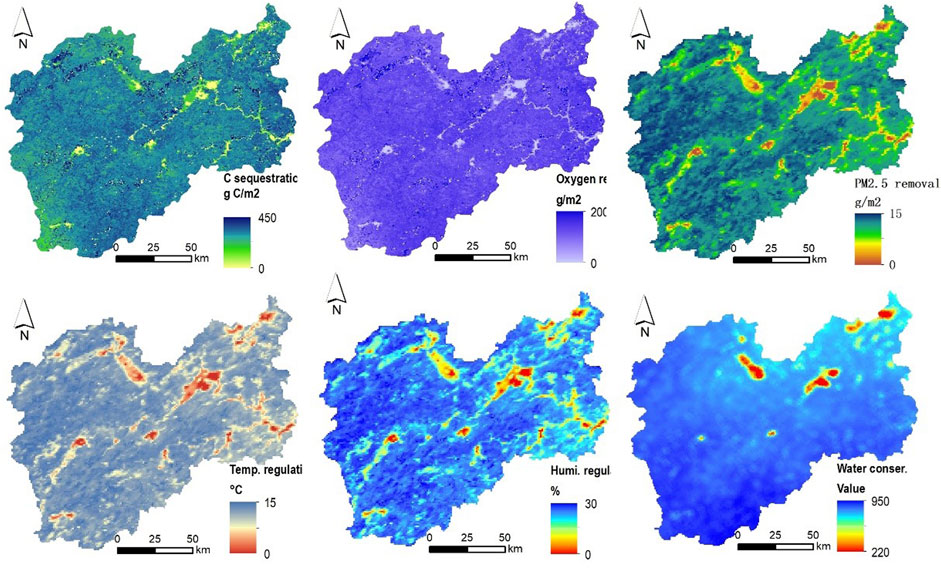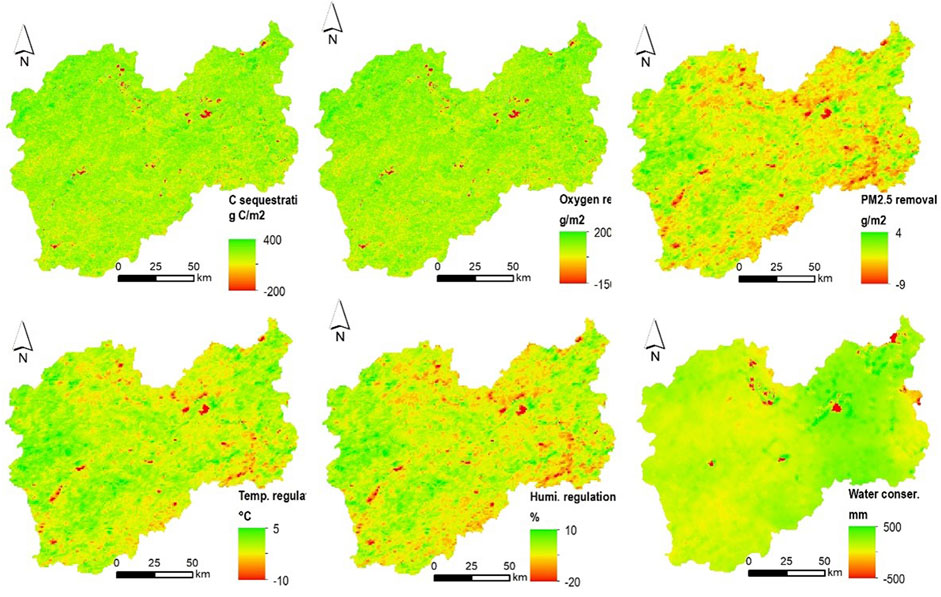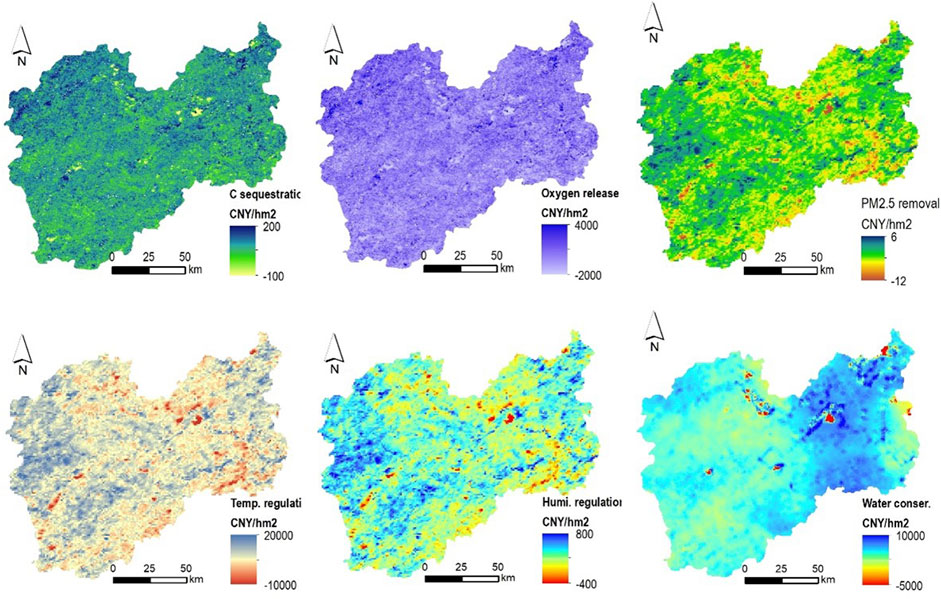- 1Lishui Institute of Land and Spatial Planning and Mapping, Lishui, China
- 2Zhejiang University of Finance and Economics, Hangzhou, China
- 3School of Business Administration, Zhejiang University of Finance and Economics Dongfang College, Haining, China
Ecological priority and green development have become the main theme of the times in China. The policy performance evaluation of ecological protection needs to quantitatively identify the changes of ecosystem quality and services firstly. This paper constructed the analytical framework driven by ecological protection policy of “Goal-oriented—Policy driven—Ecological quality–Service improvement”, and used multi-source data to establish the evaluation approach of “ecosystem quality-ecosystem services-ecosystem services value”. This study took Lishui as a case study to confirm the framework proposed. The results show that the ecosystem quality of Lishui has been steadily improved in recent 10 years. The overall quality of ecosystem services such as vegetation oxygen release, carbon sequestration, pollution removal, cooling service, humidification regulation and water conservation service has been improved by a range of 2%–6%. The value of ecological products has increased from 143.28 billion CNY in 2009 to 150.23 billion CNY in 2019. Lishui has implemented the development concept of “ecological civilization”, and the policies of ecological restoration or land remediation have changed land use and ecosystem quality, which was the main driving force for the improvement of ecological quality and the main promotion of ecological products value. The methods and results can provide insight into the impact of land policies on ecosystem services and decisions that support for further optimizing land ecological protection policies.
Introduction
With the development of industrialization and urbanization, more than 77% of land has been modified by the direct effects of human activities (Watson et al., 2018; Vargas et al., 2019; Liu et al., 2021). A large amount of natural vegetation has been destroyed, which resulted in irreversible changes in the ecosystem. At present, ecological problems have become a “bottleneck” to further economic development, and China’s economy has transformed from the stage of high-speed growth to the stage of high-quality development (Wang., 2021). The construction of ecological civilization is a major plan related to the well-being of people and the future of nature. Ecological civilization is a form of human civilization based on the premise of respecting and maintaining nature, with the connotation of establishing sustainable modes and the goal of the continued development of mankind in the future (Marinelli., 2018; Hansen et al., 2018). Adhering to the concept of “ecological civilization”, unswervingly taking the road of ecological priority and green development have become major strategic choices of national development (Jiang et al., 2019). Ecosystems contribute to economic development through the supply of ecosystem services. Information and data on ecosystem services are required to support policy making. Currently, the monitoring of ecosystem change and the accounting of ecosystem service value have become important test criteria for the effectiveness of ecological civilization construction (Jia et al., 2021; Hu and Zhang., 2021). Therefore, it is of great practical significance to establish an evaluation method for changes in ecosystem quality and to account for the value of ecosystem services.
Ecosystem services refer to all the benefits that human beings get from the ecosystem. In recent years, the accounting of ecosystem services and value has become a hot topic of research (Mancini et al., 2018; Liao et al., 2021; Wu et al., 2021). The accounting of ecosystem services value attaches a “price tag” to the clear waters and green mountains, which presents the benefits and values brought from the ecosystem to human beings visually, and provides a measurement standard for the target responsibility system of ecological environmental protection and off-office auditing of natural resource assets (Song and Ouyang., 2020). Different ecosystem types provide different services and values for human beings. In recent years, based on different study areas, time scales and ways of service classification, scholars from different countries have assessed the ecosystem services for different ecosystem types, such as forest, land, grassland and wetland (Rahimi et al., 2020; Tamburini et al., 2020). Many studies have calculated the value of ecosystem services. The results not only enrich the system of ecological value accounting methods, but also provide a theoretical basis for the evaluation of ecological protection achievements and the exploration of ecological compensation methods (Ouyang et al., 2020). The accounting of the quality and value of ecosystem services is the basis of ecological environment assessment (Li et al., 2018; Chen et al., 2022). Besides, through the accounting of the quality and value of ecosystem services, the spatial and temporal pattern change of ecosystem services and functions can be expressed (Wu et al., 2015; Xiang et al., 2022). However, the current research focuses on the quality and value accounting of ecosystem services, and there is still insufficient research on the practice of ecosystem service value changes and policy performance evaluation of ecological construction.
We tried to establish an ecosystem evaluation system of “ecosystem quality-ecosystem services-services value”, and explored the technical methods of monitoring the temporal and spatial changes of ecosystem quality, services and value. Lishui is one of the ecological demonstration zones in China, and it is the practice and innovation base of ecological civilization construction. This study aimed to 1) assess the temporal and spatial changes of Lishui ecosystem quality and service value in the past 10 years; 2) consider the causes and mechanisms of policy-driven ecosystem changes; 3) provide insight to the impact of land policies on ecosystem services and support for ecological construction performance evaluation.
Study area and methodology
Analytical framework
China’s eco-environmental protection is mainly a top-down government behavior. Over the past 2 decades, China’s environmental policy has two important nodes (Xu et al., 2020). First, in 2008, the State Environmental Protection Administration was upgraded to the Ministry of environmental protection (at the ministerial level) and became a constituent Department of the State Council; Second, the Chinese government proposes to establish a systematic and complete system of ecological civilization. With the goal of ecological and environmental protection, the supervision system of ecological and environmental administrative law enforcement has gradually taken shape from the central to local level, including total amount control, quantitative assessment and strict accountability (Lü et al., 2012; Li et al., 2022). Guided by the goal of ecological civilization construction of the central government, local governments refine and implement macro policies, puting forward specific implementation paths (Viglizzo et al., 2012; Albert et al., 2016; Cord et al., 2017). In order to further explore the causes and mechanisms of ecosystem quality improvement and find out ecosystem service enhancement in Lishui, we proposed an analytical framework of “Goal-oriented—policy driven—Ecological quality–Service improvement” (Figure 1).
We divide the impact of policies on ecosystem services into five stages: goal orientation, policy drive, Ecological change, ecosystem service change and feedback (Figure 1). ① Goal orientation means that local policies implement the national strategic goal of ecological civilization construction, and they are reflected in the government’s Five-Year Plan and Special Ecological plan. Lishui put forward the government objectives of ecological protection at different stages. In 2008, Lishui released the outline of ecological civilization construction for the first time in China. Lishui proposed to build an ecological civilization demonstration area in the 12th Five Year Plan in 2011. Lishui implemented national ecological protection and ecological economy demonstration area in the 13th Five Year Plan in 2016. In 2019, Lishui proposed the pilot of value realization mechanism of ecological products. ② Formulate operable policies based on ecological goal. Under the government’s goal, Lishui has issued a series of policies to implement the ecological objectives. During the 12th Five Year Plan period, it has proposed water and soil loss prevention, mine restoration to strength the protection and construction of ecological public welfare forests and nature reserves. Lishui established an automatic monitoring system for water quality and atmosphere, and improved the ability of environmental monitoring. During the 13th Five Year Plan period, Lishui carried out the demarcation of ecological red line, established ecological red line control rules, and improved the forest ecological benefit compensation system. Land remediation and ecological restoration projects were vigorously implemented, which guided farmers to move from ecologically sensitive areas to cities, freed up ecological space and reduced human interference in protected areas. ③ Policy driven changes in ecological spatial patterns and quality. Driven by eco-environmental protection policies, land use has changed, forest area has increased, environmental quality has improved, and the supply capacity of ecosystem services has improved. ④ Policies promoted the change of ecosystem services, such as provisioning services, regulating services, supporting services and cultural services. The beautiful eco-logical environment provides a material basis for economic development such as eco-tourism and ecological agriculture; ⑤Policy performance would generate feedback and incentives. Through the realization of the value of ecological products, the win-win situation of ecological protection and economic development has been realized, which not only further inspired the government to formulate ecological protection measures, but also stimulated residents to actively participate in ecological protection.
Therefore, this study mainly demonstrates the framework of “Goal-oriented—policy driven—Ecological quality–Service improvement”. Taking the ecological protection practice of Lishui as an example, this paper used remote sensing and other objective data to evaluate the changes of ecological environment quality and ecosystem services that focusing stages ③ and ④ in Lishui. This research will provide technical support for policy performance evaluation.
Study area
Lishui is located in the southwest of Zhejiang Province, China, with an area of 17,300 square kilometers and a resident population of 2.507 million (Figure 2). Besides, its urbanization rate is 61.82%. Lishui has a subtropical monsoon climate, with an annual average temperature of 11.5–18.3°C. The surface of Lishui belongs to the hills in the south of the Yangtze River, and the forest coverage reaches 81.7% (Wu et al., 2021; Diao et al., 2022). It is the most ecologically preserved area in East China. Its superior ecological environment is not only an important green ecological barrier in East China, but also one of the centers of biodiversity, which plays a decisive role in the ecosystem stability of Zhejiang Province and even the whole East China.
Lishui is an important birthplace and practice place of the concept that “Clear waters and green mountains are as good as mountains of gold and silver” in China. As one of the first batch of national ecological civilization pilot demonstration areas in China, Lishui has adhered to the ecological priority green development strategy chronically. Lishui issued a series of policies to protect the ecosystem and improve the environmental quality in the past decade. The ecological environment quality and people’s living standards of Lishui have been improving steadily. Among them, indicators such as ecological environment quality, development process index, and farmers’ income growth have been in the forefront of Zhejiang Province for many years.
Methodology
We used multi-source remote sensing to interpret data products and analyzed the changing characteristics of land use, ecological quality and ecosystem services in Lishui from 2009 to 2019 by means of ecological analysis and ecosystem service value accounting. TM images interpretation data and statistical data from natural resources administration were used to study how policy driven land use change. Ecosystem quality was characterized by net primary productivity (NPP) and leaf area index (LAI). The data were mainly from MODIS and the spatial resolution of NPP and LAI is 500 m.
For a specific region, the ecosystem provides a variety of different services. It requires to grasp one or more core services representative and typical in the area while assessing regional ecosystem regulation services (Zhao., 2015). By considering the actual situation around Lishui city and scientific operability, we choose six regulating services to assess regulating services of Lishui city, including carbon sequestration, oxygen release, PM2.5 removal, temperature regulation, humidification adjustment, water conservation. These regulating services mentioned above are particularly important in Lishui City. The basic parameters including the dry deposition flux of PM2.5, daily transpiration, daily variation of regional water pressure, measured precipitation, measured stand evapotranspiration. All meteorological data was obtained from China Meteorological Data (http://data.cma.cn/) and the spatial resolution of all the meteorological data is 500 m by Kriging interpolation. The specific evaluation methods of ecosystem services are shown in Table 1.
The quantification of ecological product value was mainly based on the Gross Ecosystem Production (GEP) accounting method (Zhejiang Provincial Market Supervision Administration, 2020). It was calculated by multiplying the unit price of the substitute. The price coefficient per unit quantity is shown in Table 2.
Results
Changes of ecosystem quality in Lishui
Net primary productivity (NPP) and leaf area index (LAI) were used to characterize ecosystem quality. Based on the remote sensing image data from 2009 to 2019, the change trend of NPP and LAI was analyzed using the pixel-by-pixel slope method with a resolution of 500 m (Figure 3). The results showed that both NPP and LAI in Lishui showed an upward trend in recent 10 years, as shown in Figure 2. 93% of the Land, NPP showed an increasing trend, of which 24% had a significant increase, and 69% had an insignificant increase. 74% of the land LAI showed an increasing trend, of which 18% had a significant increase, and 56% had an insignificant increase. The city’s NPP increased at an average rate of 4 g C m−2 per year, and the LAI increased at an average rate of 0.8% per year, indicating that the quality of Lishui’s ecosystem was overall improved.
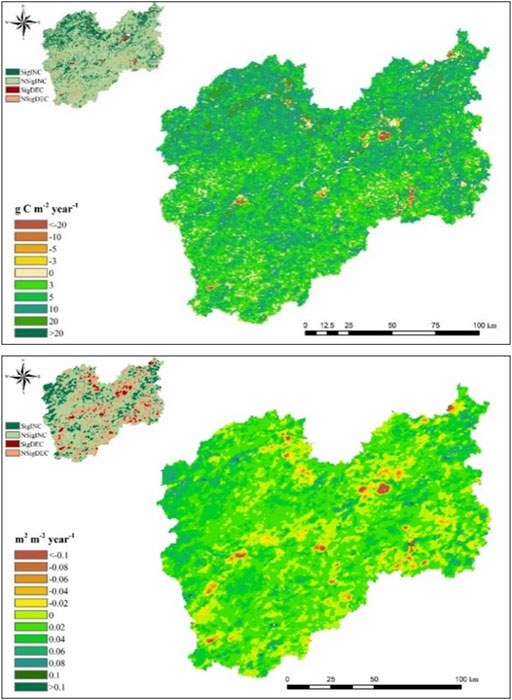
FIGURE 3. Change rate of NPP and Lai (SigINC, significantly increased; NSigINC, increased but not significantly; SigDEC, significantly decreased; NSigDEC decreased but not significantly).
The trend of significant decline in NPP and LAI had similar characteristics in space. 7% of the urban land, NPP showed a downward trend, but only 0.9% of the land reached a significant level. LAI declined in the 26% of the land, and 3.5% reached a significant level of decline. Significant decline of NPP and LAI were mainly distributed in the areas of rapid urbanization. The conversion of ecological land and cultivated land into urban land was the main reason for the decline of ecosystem quality.
Temporal and spatial changes of ecosystem service
The average values of carbon sequestration and oxygen release in 2009 were 90.1 g C m−2 a−1 and 175.3 g m−2 a−1. Carbon sequestration and oxygen release were related to vegetation productivity so they had a similar spatial pattern. High value areas of them were in areas with high forest cover, such as Qingyuan, Longquan and Suichang, while low value areas were in urban and farmland-intensive areas, respectively. The average values of pollution removal, temperature regulation and humidity regulation were 1.6g m-2, 6.6°C and 14.7%. These three types of services are related to the leaf area index, therefore they have similar spatial patterns. Areas with stable vegetation system and complete canopy structure were high-value areas, while towns and farmland were low-value areas. The variation range of water conservation was 176–958 mm, and the average value was 855 mm. Water conservation is a comprehensive function of precipitation, vegetation and terrain. The southern part of Lishui was higher than the northern part, as shown in Figure 4.
The spatial distribution pattern of ecosystem services in 2019 is shown in Figure 5. We took 2009 as the benchmark, and the range of ecosystem service improvement was between 2 and 6%. Spatial pattern of ecosystem service changes in Lishui from 2009 to 2019 were shown in Figure 6. In the past 10 years, ecosystem services in Lishui have shown an upward trend, but there was an obvious downward trend in urbanized areas rapidly. The temperature regulation service had the largest increase, reaching 6%, from 6.6 to 7.0°C. The increase in pollution removal services was relatively small by 2%. The areas with higher improvement of ecosystem services were the areas where the quality of ecological environment had improved better in the past decade, such as the northwest of Lishui. The increase in the areas with stable eco-environmental quality was relatively small, such as the nature reserves where the forests are mature. Urbanization had a great impact on local ecosystem services, and the material quality of some ecosystem services could be reduced by 80%.
Temporal changes of ecosystem service value
The method of ecosystem service quality characterized the physical meaning of ecosystem service well, but it lacks comparability and intuitiveness, so we used Gross Ecosystem Production (GEP) accounting method to calculate the value of ecosystem services on the basis of material quality accounting (Table 3). In 2019, the total value of six ecosystem services surpassed 150 billion, and there were great differences among them. Temperature regulation reached 104.5 billion CNY, accounting for 70%, water conservation 40.78 billion CNY, accounting for 27%, and the other four types accounted for only 3%.
In the past decade, the total value of the six ecosystem services increased from 143.28 billion CNY in 2009 to 150.23 billion CNY in 2019, with a net increase of 6.95 billion CNY. The temperature regulation service rose from 173 billion kWh in 2009 to 183.4 billion kWh in 2019, with a value increase of 5.92 billion CNY. The areas with a large increase are in the west and southwest of Lishui, where the level of economic development is low. Water conservation grew from 14.8 billion cubic meters in 2009 to 15.1 billion cubic meters in 2019, with a value increase of 1.64 billion CNY. The largest in-crease was in the central area of Lishui. Carbon sequestration service rose from 1.56 Mt in 2009 to 1.63 Mt in 2019, and its value increased from 230 million CNY to 240 million CNY, with the largest increase in the north of Lishui. The spatial pattern of ecosystem services decline had similar distribution characteristics, and the ecosystem service value decreased significantly in the rapid urbanization area (Figure 7).
Discussion
The evolution of land ecological protection polices in Lishui
Lishui’s ecological land area is significant, and Lishui’s ecological policy is broader and deeper than other prefecture-level cites in Zhejiang province. The evolution of land ecological protection polices in Lishui could be divided into three stages: strategic policy, implementation projects and process supervision. They affected the ecosystem at different stages. Firstly, Lishui Government put forward the overall strategic concept of ecological civilization construction since 2008 in order to implement the concept of “ecological civilization”. Adhering to the ecological priority green development strategy firmly, Lishui gradually established the management system and policy system reflecting ecological construction. Secondly, under the guidance of the concept of “ecological civilization”, Lishui had formulated a series of plans and project to enhance the value of ecosystem services, including ecological restoration, land renovation and environmental quality improvement (Wu et al., 2021). At the same time, Lishui promoted ecological restoration through actions such as nature reserve construction, soil and water conservation, water ecosystem restoration, mine ecological management, etc. Lishui implemented citywide renovation to optimize the ecological factor structure of mountains, waters, forests, fields and lakes in this city (Diao et al., 2022). Thirdly, Lishui ensured the coordination of monitoring and management of dynamic changes of water, soil and atmospheric environmental quality, which promoted the improvement of ecosystem quality and ecosystem service. It was precisely because of the whole process of ecological protection policy from strategy to implementation to supervision that the ecological quality of Lishui had been continuously improved in the past decade.
Policies driving ecosystem quality and service change
Policies and actions such as ecological restoration, integrated land management promoted land use change directly, which was the key process of ecosystem services and value change (Liu et al., 2010; Zhao et al., 2017). In 2019, the total area of forest land in Lishui was 1,385,761.51 ha, an increase of 20,667.36 ha compared with 2009. In the past decade, the impact of short-term climate change on ecosystems was less than the impact of land policies. The main reason for land use change in Lishui was driven by land ecological protection policies and actions. Through afforestation and ecological restoration, a large number of bare lands was planted with trees, and the number of shrubs increased by 40,378.85 ha. The protection of forests and the reduction of human disturbance made the vegetation grow better. The improvement of woodland and other ecological land in the whole area has promoted the growth of NPP at the rate of 4 g C m−2 per year, and LAI at the rate of 0.8% per year. Therefore, ecosystem services such as carbon sequestration and water conservation have been significantly improved. Therefore, we consider that policy driven land use change was the most important reason for improving ecosystem quality and ecosystem services.
While the quality and value of the overall ecosystem services in Lishui have improved, the changes in the value of partial ecosystem services have decreased, particularly in areas with rapid urbanization and high levels of economic development. In the past 10 years, urban and rural construction land in the city has increased by 2,300 ha. The conversion of agricultural land and ecological land into construction land has led to a decline in ecosystem productivity and service supply capacity, resulting in an obvious decline in the value of ecosystem services in these areas. (Gao et al., 2020; Chen et al., 2021).
Implications and limitations
The policy analysis framework proposed in this paper could be used to evaluate the impact of policies on ecosystems. This study represented spatial-explicitly changes of ecological quality and ecosystem services, which could provide a basis for the targeted land ecological protection policy. We could find the areas where the ecological quality was improved quickly and identify the effectiveness of land ecological protection policies in these areas through the spatial-explicitly ecological quality and system service evaluation. At the same time, we could also identify those areas with degraded ecological quality and services, find out the causes of degradation, and then we could propose targeted improvement strategies. For example, we found that ecosystem services in areas with rapid urbanization and conversion of forest land to arable land declined rapidly. The policies of compact development and intensive agricultural utilization might effectively avoid the decline of ecological quality and ecosystem services.
The uncertainty of this study mainly came from the accuracy of data and the diversity of ecosystem services. We used remote sensing data with an accuracy of 500 m, and the interpretation results were insufficient to characterize the spatial changes of the ecosystem. At present, there are various methods to evaluate the function and value of ecosystem services, and different evaluation methods may lead to differences in evaluation results. The evaluation model of ecosystem services needs to be further improved and unified. Qualitative analysis of the impact of policy on ecosystem is the main limitation of this study. We plan to quantify the contribution of policy in the further study. In addition, climate change is also an important factor on ecosystem quality and service changes. Separating the contributions of human factors and climate changes to ecosystem services is an important direction for further research.
Conclusion
We proposed an evaluation framework of “Goal-oriented-Policy driven-Ecological quality-Service improvement” for ecosystem quality and service change. The empirical study showed that the NPP and LAI of Lishui represented an increasing trend in the past 10 years. The supply capacity of ecosystem services in Lishui had been enhanced.
The analysis framework can be used to evaluate the impact of policies on ecosystems. Under the goal of green development, policy actions promoted the optimization of land use structure and reduced human disturbance, which was the main driving force for the improvement of ecological environment quality and the value of ecological products in Lishui. Qualitative analysis of the impact of policy on ecosystem is the main limitation of this study. Qualifying and separating the contribution of human factors and climate changes to ecosystem services is an important direction for further research.
Data availability statement
The raw data supporting the conclusions of this article will be made available by the authors, without undue reservation.
Author contributions
Writing—original draft preparation, YT and DC; writing—review and editing, LQ, XH, and JW; investigation, JT and XY; conceptualization, DC. All authors have read and agreed to the published version of the manuscript.
Funding
This research was funded by the Project of Humanities and Social, Ministry of Education, grant number “20YJCZH006”.
Conflict of interest
The authors declare that the research was conducted in the absence of any commercial or financial relationships that could be construed as a potential conflict of interest.
Publisher’s note
All claims expressed in this article are solely those of the authors and do not necessarily represent those of their affiliated organizations, or those of the publisher, the editors and the reviewers. Any product that may be evaluated in this article, or claim that may be made by its manufacturer, is not guaranteed or endorsed by the publisher.
References
Albert, C., Bonn, A., Burkhard, B., Daube, S., Dietrich, K., Engels, B., et al. (2016). Towards a national set of ecosystem service indicators: Insights from Germany. Ecol. Indic. 61, 38–48. doi:10.1016/j.ecolind.2015.08.050
Chen, L., Chen, L., Zhu, Z., Han, L., and Cao, Y. (2021). Development potential of forestry carbon sequestration projects in natural forest protection project area: Taking heilongjiang natural forest protection project area as an example. Acta Agric. Zhejiangensis 33 (05), 944–954. doi:10.1016/j.ecolind.2015.08.050
Chen, Z., Li, Y., Liu, Z., Wang, J., and Liu, X. (2022). Impacts of different rural settlement expansion patterns on eco-environment and implications in the loess hilly and gully region, China. Front. Environ. Sci. 10 (03), 857776. doi:10.3389/fenvs.2022.857776
Cord, A. F., Bartkowski, B., Beckmann, M., Dittrich, A., Hermans-Neumann, K., Kaim, A., et al. (2017). Towards systematic analyses of ecosystem service trade-offs and synergies: Main concepts, methods and the road ahead. Ecosyst. Serv. 28, 264–272. doi:10.1016/j.ecoser.2017.07.012
Diao, J., Liu, J., Zhu, Z., Wei, X., and Li, M. (2022). Active forest management accelerates carbon storage in plantation forests in Lishui, southern China. For. Ecosyst. 9 (01), 100004–100046. doi:10.1016/j.fecs.2022.100004
Gao, M., Wang, Y., Gao, J., Wang, J., and Mao, Y. (2020). Analysis on changes and relationship of ecosystem services in karst area under the project of returning farmland to forest. Res. Soil Water Conservation 27 (02), 276–283. doi:10.13869/j.cnki.rswc.2020.02.039
Hansen, M. H., Li, H., and Svarverud, R. (2018). Ecological civilization: Interpreting the Chinese past, projecting the global future. Glob. Environ. Change 53, 195–203. doi:10.1016/j.gloenvcha.2018.09.014
Hu, K., and Zhang, Z. (2021). Spatio-temporal characteristics and driving-factors analysis of ecological quality change in qinling mountains of shaanxi Province: Case study in liuba county, north west China. J. Ecol. Rural Environ. 37 (06), 751–760. doi:10.19741/j.issn.1673-4831.2020.0884
Jia, Y., Liu, Y., and Zhang, S. (2021). Evaluation of agricultural ecosystem service value in arid and semiarid regions of northwest China based on the equivalent factor method. Environ. Process. 8 (2), 713–727. doi:10.1007/s40710-021-00514-2
Jiang, B., Bai, Y., Wong, C. P., Xu, X., and Alatalo, J. M. (2019). China’s ecological civilization program–Implementing ecological redline policy. Land Use Policy 81, 111–114. doi:10.1016/j.landusepol.2018.10.031
Li, H., Mao, D., Li, X., Wang, Z., Jia, M., Huang, X., et al. (2022). Understanding the contrasting effects of policy-driven ecosystem conservation projects in northeastern China. Ecol. Indic. 135, 108578. doi:10.1016/j.ecolind.2022.108578
Li, L., Su, F., Brown, M. T., Liu, H., and Wang, T. (2018). Assessment of ecosystem service value of the liaohe estuarine wetland. Appl. Sci. 8 (12), 2561. doi:10.3390/app8122561
Liao, Z, He, P., Gao, X., Lin, Z., Fang, C., Zhou, W., et al. (2021). Identifying critical area of ecosystem service supply and demand at different scales based on spatial heterogeneity assessment and SOFM neural network. Front. Environ. Sci. 9 (07), 714874. doi:10.3389/fenvs.2021.714874
Liu, M., Hu, Y. M., Chang, Y., Bu, R. C., He, H. S., Chen, H. W., et al. (2010). [Effects of eco-protection policy on land use/cover in upper reaches of Minjiang River]. Chin. J. Appl. Ecol. 21 (06), 1351–1358. doi:10.13287/j.1001-9332.2010.0234
Liu, Y., Geng, W., Shao, J., Zhou, Z., and Zhang, P. (2021). Land use change and ecosystem service value response from the perspective of “ecological-production-living spaces”: A case study of the lower yellow river. Areal Res. Dev. 40 (04), 129–135. doi:10.3969/j.issn.1003-2363.2021.04.023
Lü, Y., Fu, B., Feng, X., Zeng, Y., Liu, Y., Chang, R., et al. (2012). A policy-driven large scale ecological restoration: Quantifying ecosystem services changes in the loess plateau of China. PloS one 7 (2), e31782. doi:10.1371/journal.pone.0031782
Mancini, M. S., Galli, A., Coscieme, L., Niccolucci, V., Lin, D., Pulselli, F. M., et al. (2018). Exploring ecosystem services assessment through Ecological Footprint accounting. Ecosyst. Serv. 30, 228–235. doi:10.1016/j.ecoser.2018.01.010
Marinelli, M. (2018). How to build a ‘beautiful China’ in the anthropocene. The political discourse and the intellectual debate on ecological civilization. J. Chin. Polit. Sci. 23, 365–386. doi:10.1007/s11366-018-9538-7
OuYang, Z., Lin, Y., and Song, C. (2020). Research on Gross ecosystem product(GEP):a case study of Lishui city. Zhejiang Prov. Environ. Sustain. Dev. 45 (06), 80–85. doi:10.19758/j.cnki.issn1673-288x.202006080
Rahimi, L., Malekmohammadi, B., and Yavari, A. R. (2020). Assessing and modeling the impacts of wetland land cover changes on water provision and habitat quality ecosystem services. Nat. Resour. Res. 29 (6), 3701–3718. doi:10.1007/s11053-020-09667-7
Song, C., and OuYang, Z. (2020). Gross ecosystem product accounting for ecological benefits assessment: A case study of qinghai Province. Acta Ecol. Sin. 40 (10), 3207–3217. doi:10.5846/stxb202004260999
Tamburini, G., Bommarco, R., Wanger, T. C., Kremen, C., van der Heijden, M. G. A., Liebman, M., et al. (2020). Agricultural diversification promotes multiple ecosystem services without compromising yield. Sci. Adv. 6 (45), 1715. doi:10.1126/sciadv.aba1715
Vargas, L., Willemen, L., and Hein, L. (2019). Assessing the capacity of ecosystems to supply ecosystem services using remote sensing and an ecosystem accounting approach. Environ. Manag. 63 (1), 1–15. doi:10.1007/s00267-018-1110-x
Viglizzo, E. F., Paruelo, J., Laterra, P., and Jobbagy, E. (2012). Ecosystem service evaluation to support land-use policy. Agric. Ecosyst. Environ. 154, 78–84. doi:10.1016/j.agee.2011.07.007
Wang, Y. (2021) The scientific connotation and significance of general secretary xi jinping's "two mountains" theory. Frontiers 2021 (08), 112–115. doi:10.16619/j.cnki.rmltxsqy.2021.08.012
Watson, J. E. M., Venter, O., Lee, J., Jones, K. R., Robinson, J. G., Possingham, H. P., et al. (2018). Protect the last of the wild. Nature 563 (7729), 27–30. doi:10.1038/d41586-018-07183-6
Wu, S., Yu, Y., Zhu, J., Li, B., and Zhou, S. (2015). Soil ecosystem services: Concept, quantification and response to urbanization. Acta Pedol. Sin. 52 (05), 970–978. doi:10.11766/trxb201409250488
Wu, S., Hung, M. H., Ting, C. K., Illias, A. M., Lu, C. H., Tsou, M. Y., et al. (2021). COVID-19 pandemic: Taiwan society of anesthesiologists' response to the ethical aspects of health and safety in operating room management. Asian J. Anesthesiol. 35 (04), 81–82. doi:10.6859/aja.202109_59(3).0001
Xiang, M., Yang, J., Li, W., Song, Y., Wang, C., Liu, Y., et al. (2022). Spatiotemporal evolution and simulation prediction of ecosystem service function in the western sichuan plateau based on land use changes. Front. Environ. Sci. 10 (04), 890580. doi:10.3389/fenvs.2022.890580
Xu, X., Guo, P., Zhang, F., Wu, H., and Guo, W. (2020). Analysis for changing ecological effects under policy-driven in shiyang river basin. J. Soil Water Conservation 34 (06), 185–191. doi:10.13870/j.cnki.stbcxb.2020.06.027
Zhao, H. (2015). Research progress of classification and value evaluation of ecosystem services. Ecol. Econ. 31 (08), 27–33. doi:10.3969/j.issn.1671-4407.2015.08.006
Zhao, M., Cui, N., Qu, F., Huang, X., Yang, H., Nie, S., et al. (2017). Novel nano-particulated exopolysaccharide produced by Klebsiella sp. PHRC1.001. Carbohydr. Polym. 24 (02), 252–258. doi:10.1016/j.carbpol.2017.05.015
Keywords: ecological civilization, ecological quality, ecological economic, ecosystem service, land use, spatial analysis
Citation: Tang Y, Tang J, Yu X, Qiu L, Wang J, Hou X and Chen D (2022) Land ecological protection polices improve ecosystem services: A case study of Lishui, China. Front. Environ. Sci. 10:973524. doi: 10.3389/fenvs.2022.973524
Received: 20 June 2022; Accepted: 22 August 2022;
Published: 20 September 2022.
Edited by:
Junxiang Li, Shanghai Jiao Tong University, ChinaReviewed by:
Yu Tao, Nanjing Agricultural University, ChinaXiao Sun, Chinese Academy of Agricultural Sciences (CAAS), China
Copyright © 2022 Tang, Tang, Yu, Qiu, Wang, Hou and Chen. This is an open-access article distributed under the terms of the Creative Commons Attribution License (CC BY). The use, distribution or reproduction in other forums is permitted, provided the original author(s) and the copyright owner(s) are credited and that the original publication in this journal is cited, in accordance with accepted academic practice. No use, distribution or reproduction is permitted which does not comply with these terms.
*Correspondence: Dongxiang Chen, MjAxOTAzMDJAenVmZWRmYy5lZHUuY24=
 Yisheng Tang1
Yisheng Tang1 Dongxiang Chen
Dongxiang Chen